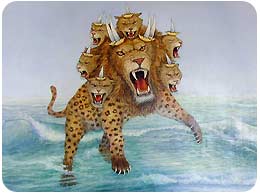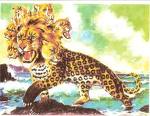

"Can the Ethiopian change his skin, or the
leopard his spots?"
Jeremiah 13:23
Leopard & Ounce
THE leopard is an inhabitant of Africa,
India, and the Indian Islands. A black
variety inhabits Java, and is not uncommon
there.
Its height is about two feet. This and the
following Felide are accustomed to live
much on trees, and are on that account
called tree-tigers by the natives. Nothing
can be more beautiful than the elegant and
active manner in which the leopards sport
among the branches of the trees; at one
time they will bound from branch to branch
with such rapidity that the eye can
scarcely follow them; then, as if tired, they
will suddenly stretch themselves along a
branch so as to be hardly distinguishable
from the bark, but start up again on the
slightest provocation, and again resume
their graceful antics. It is easily tamed,
and expresses great fondness for its
keeper, and will play with him like a cat.
A remarkably beautiful specimen in Womb-
well's Menagerie was exceedingly fond of
playing with the tuft at the extremity of a
lion's tail, and from the familiar manner in
which he patted and bit it, he evidently
considered it as manufactured for his own
particular entertainment.
This animal is exceedingly fond of some
scents, especially preferring lavender
water, by means of which predilection it
has been taught to perform several tricks.
The leopard and panther are considered
as the same animal, on the authority of Mr.
Gray.
THE OUNCE.
The Ounce is a native of India, and has
been often confounded with the leopard. Its
fur is much more rough than that of the
leopard, and the tail is almost bushy,
especially toward the extremity. Its body is
marked with irregular, wavy stripes, and
the head is adorned with black spots. The
general color is a yellowish gray.
It is easy to distinguish the ounce from the
leopard, by the distinctness of the
markings, and also by the roughness of the
fur, which latter distinction, in the opinion
of some naturalist, shows that it lives in
mountainous regions. The habits and
history of this animal are but little known.

Bible Leopard Beast
And I stood upon the sand of the sea, and saw a beast rise up out of the sea, having seven heads and ten horns, and upon his horns ten crowns, and upon his heads the name of blasphemy.
And the beast which I saw was like unto a leopard, and his feet were as the feet of a bear, and his mouth as the mouth of a lion: and the dragon gave him his power, and his seat, and great authority.
And I saw one of his heads as it were wounded to death; and his deadly wound was healed: and all the world wondered after the beast.
And they worshipped the dragon which gave power unto the beast: and they worshipped the beast, saying, Who is like unto the beast? who is able to make war with him?
And there was given unto him a mouth speaking great things and blasphemies; and power was given unto him to continue forty and two months.
And he opened his mouth in blasphemy against God, to blaspheme his name, and his tabernacle, and them that dwell in heaven.
And it was given unto him to make war with the saints, and to overcome them: and power was given him over all kindreds, and tongues, and nations.
And all that dwell upon the earth shall worship him, whose names are not written in the book of life of the Lamb slain from the foundation of the world.
Revelation 13:1-8
Leopard In The Bible
The line of prophecy in which these symbols are found, begins with Revelation 12, with the dragon that sought to destroy Christ at his birth. The dragon is said to be Satan; [Revelation 12:9.] he it was that moved upon Herod to put the Saviour to death. But the chief agent of Satan in making war upon Christ and his people during the first centuries of the Christian era, was the Roman Empire, in which paganism was the prevailing religion. Thus while the dragon, primarily, represents Satan, it is, in a secondary sense, a symbol of pagan Rome.
In chapter 13 [Revelation--- 1-10.] is described another beast, “like unto a leopard,” to which the dragon gave “his power, and his seat, and great authority.” This symbol, as most Protestants have believed, represents the papacy, which succeeded to the power and seat and authority once possessed by the ancient Roman Empire. Of the leopard-like beast it is declared: “There was given unto him a mouth speaking great things and blasphemies. . . . And he opened his mouth in blasphemy against God, to blaspheme his name, and his tabernacle, and them that dwell in Heaven. And it was given unto him to make war with the saints, and to overcome them; and power was given him over all kindreds, and tongues, and nations.” This prophecy, which is nearly identical with the description of the little horn of Daniel 7, unquestionably points to the papacy.
“Power was given unto him to continue forty and two months.” And, says the prophet, “I saw one of his heads as it were wounded to death.”
GC88 438-439

LEOPARDS IN PAY FOR LEARNING.
A CRY FROM AFRICA.
THERE is a gentleman in Philadelphia, Mr. Edward S. Morris, who is greatly interested in the children of Africa, and is doing all he can to provide schools for them. Any assistance will be thankfully received.
He has kindly furnished the picture in this paper, representing an African boy with two baby leopards in his arms, with which he tried to buy his passage to America. He tells the touching story of this boy's desire for knowledge as follows:
"It was at sunset one beautiful Sabbath day, as I stood for the last time on the beach at Monrovia, waiting for my boat to take me out to the anchored vessel at sea.
A little native boy came to me, bowing low, but with his eyes firmly fixed upon me.
I told him to stand up and never bow to man. Understanding my actions more than the words, he stood up. I then said, 'What do you want?'
In broken, disjointed English the best the little fellow could utter and pointing out to the ship, he said, You God-man take me big America, big ship.'
'What for?' I asked. He answered, 'Me learn big English you.'
"In consequence of my then enervated condition from over-work, I was forced to say ' No' to the little fellow. I did not say it harshly, but in mild and gentle accents; whereupon he immediately drew forth from the fold of a cloth around him, two little leopards, alive, with unopened eyes, and presenting them said, 'Me give him; you take me big America, big ship, learn big English.' Think of it, readers;
the mother leopard must to his knowledge have been near when he captured her kittens; still, that hungry, thirsting child, risked his life to earn a passage to America, solely to gain an education.
"This little boy could have obtained as his passage money without any such risk of life, a parrot or a beautiful gazelle, the tusk of an elephant, or large ear-rings of pure African gold; but no, he wanted to convince me at the beginning, not only of his bravery, but of his burning desire for education, for 'big English,' as he called it. I have no words to tell you of my feelings so -- suddenly and unexpectedly brought into action.
I only know that there and then I resolved myself into a life-long committee of one, with power to act, promising to leave nothing undone to practically answer the cry of that little boy."
And there are hundreds of thousands more in that country burning for an education; and they should be taught not only "big English," but about God and the way to Heaven.
V. A. M.